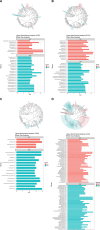Oncogenic human papillomavirus and anal microbiota in men who have sex with men and are living with HIV in Northern Taiwan
- PMID: 39739827
- PMCID: PMC11687658
- DOI: 10.1371/journal.pone.0304045
Oncogenic human papillomavirus and anal microbiota in men who have sex with men and are living with HIV in Northern Taiwan
Abstract
Few studies have demonstrated the interplay between human immunodeficiency virus (HIV), anal human papillomavirus (HPV), and anal microbiota, especially in persons living with HIV who are men who have sex with men. We, therefore, explored these interrelationships in a cohort of persons living with HIV, mainly comprising men who have sex with men. HPV genotyping using a commercial genotyping kit and ThinPrep cytology interpreted by Bethesda systems was performed on samples from 291 patients. Samples were characterized by high-throughput sequencing of dual-index barcoded 16s rRNA (V3-4). Bacterial diversity was diminished in individuals living with HIV with CD4+ T cells <500 cells/μL and anal cytology yielding atypical squamous cells of undetermined significance or higher grades (ASCUS+) with detectable HPV 16/18 compared with those with CD4+ T cells ≥500 cells/μL with ASCUS+ and HPV 16/18 and those with normal anal cytology or inflammation without HPV 16/18. Enterobacteriaceae, Ruminococcus, and Bacilli were significantly abundant in persons living with HIV with CD4+ T cells <500 cells/μL with ASCUS+ and HPV 16/18. Bacterial diversity, composition, and homogeneity of dispersion were different in individuals living with HIV with low CD4+ T cells with ASCUS+ and HPV 16/18, and understanding the interaction among immunocompromised hosts, oncogenic HPVs, and microbiota is essential, and the contribution of these factors to anal precancerous lesions needs more in-depth exploration.
Copyright: © 2024 Cheng et al. This is an open access article distributed under the terms of the Creative Commons Attribution License, which permits unrestricted use, distribution, and reproduction in any medium, provided the original author and source are credited.
Conflict of interest statement
The authors have declared that no competing interests exist.
Figures




Similar articles
-
Multiple types of human papillomavirus infection and anal precancerous lesions in HIV-infected men in Taiwan: a cross-sectional study.BMJ Open. 2018 Jan 27;8(1):e019894. doi: 10.1136/bmjopen-2017-019894. BMJ Open. 2018. PMID: 29374678 Free PMC article.
-
A rigorous exploration of anal HPV genotypes using a next-generation sequencing (NGS) approach in HIV-infected men who have sex with men at risk for developing anal cancer.Cancer Med. 2020 Jan;9(2):807-815. doi: 10.1002/cam4.2720. Epub 2019 Nov 25. Cancer Med. 2020. PMID: 31769225 Free PMC article.
-
Human papillomavirus prevalence in the anus and urine among HIV-infected Japanese men who have sex with men.J Infect Chemother. 2017 Sep;23(9):621-626. doi: 10.1016/j.jiac.2017.06.005. Epub 2017 Jul 6. J Infect Chemother. 2017. PMID: 28688605
-
Human papillomavirus infection & anal cytological abnormalities in HIV-positive men in eastern India.BMC Infect Dis. 2018 Dec 27;18(1):692. doi: 10.1186/s12879-018-3618-3. BMC Infect Dis. 2018. PMID: 30587145 Free PMC article.
-
Prevalence of HPV in anal cancer: exploring the role of infection and inflammation.Infect Agent Cancer. 2024 Dec 18;19(1):63. doi: 10.1186/s13027-024-00624-0. Infect Agent Cancer. 2024. PMID: 39696546 Free PMC article. Review.
References
-
- zur Hausen HA. The role of papillomaviruses in anogenital cancer. Scand J Infect Dis Suppl. 1990;69: 107–111. - PubMed
MeSH terms
Substances
LinkOut - more resources
Full Text Sources
Medical
Research Materials

